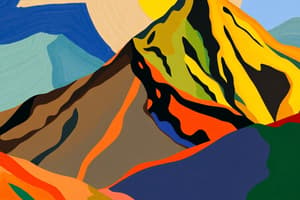Podcast
Questions and Answers
What is the Colorado Plateau characterized by?
What is the Colorado Plateau characterized by?
high elevation, arid climate, and diverse landscapes
What do plateaus often mark the boundaries of?
What do plateaus often mark the boundaries of?
different tectonic plates
What are deserts characterized by?
What are deserts characterized by?
extreme temperatures, minimal vegetation, and little rainfall
What is the world's largest desert?
What is the world's largest desert?
Why are deserts often not suitable for human life or large-scale agriculture?
Why are deserts often not suitable for human life or large-scale agriculture?
What is the significance of understanding different landforms?
What is the significance of understanding different landforms?
What are landforms, and how are they created?
What are landforms, and how are they created?
How are mountains typically formed?
How are mountains typically formed?
What is a characteristic feature of mountains?
What is a characteristic feature of mountains?
What is a valley, and how is it formed?
What is a valley, and how is it formed?
How are plateaus formed, and what are their characteristics?
How are plateaus formed, and what are their characteristics?
Which landform is not mentioned in the article?
Which landform is not mentioned in the article?
Flashcards are hidden until you start studying
Study Notes
Landforms: Mountains, Valleys, Plateaus, and Deserts
Landforms are natural features that shape the Earth's surface. They are created by various geological processes, such as tectonic movements, erosion, and volcanic activity, and they play a crucial role in shaping the planet's climate, ecosystems, and human settlement patterns. In this article, we will explore the four major types of landforms: mountains, valleys, plateaus, and deserts.
Mountains
Mountains are towering landforms with steep slopes and high elevations. They are typically formed by the collision of tectonic plates or volcanic activity. Some famous mountain ranges include the Himalayas, the Rockies, and the Andes. Mount Everest, located in the Himalayas, is the world's tallest mountain, with a peak over 29,000 feet. Mountains can have a significant impact on weather patterns, creating rain shadows and influencing temperature and precipitation.
Valleys
Valleys are low-lying landforms that lie between hills or mountains. They can be created by rivers, glaciers, or tectonic forces. Yosemite Valley in California is an iconic example of a valley, known for its scenic beauty and steep cliffs. Valleys often provide fertile soil for agriculture and can channel water, which is essential for the growth of crops and human settlements.
Plateaus
Plateaus are elevated, flat-topped landforms that cover vast areas. They are typically formed by geological uplift or lava accumulation. The Colorado Plateau in the United States is an excellent example of a plateau, characterized by its high elevation, arid climate, and diverse landscapes. Plateaus can also have significant geological significance, as they often mark the boundaries between different tectonic plates.
Deserts
Deserts are arid regions with minimal vegetation and little rainfall. They can be sandy, rocky, or both and are formed due to specific climatic conditions. The Sahara Desert in Africa is the world's largest desert. Deserts are characterized by extreme temperatures, both in summer and winter, and they often lack the water resources necessary for sustaining human life or large-scale agriculture.
In conclusion, landforms play a crucial role in shaping the Earth's geography, climate, and ecosystems. Understanding these different landforms can help us appreciate the diverse landscapes we see today and the processes that shaped them. From the towering mountains to the vast deserts, each landform has its unique characteristics and formation process, making them essential parts of our planet's story.
Studying That Suits You
Use AI to generate personalized quizzes and flashcards to suit your learning preferences.





